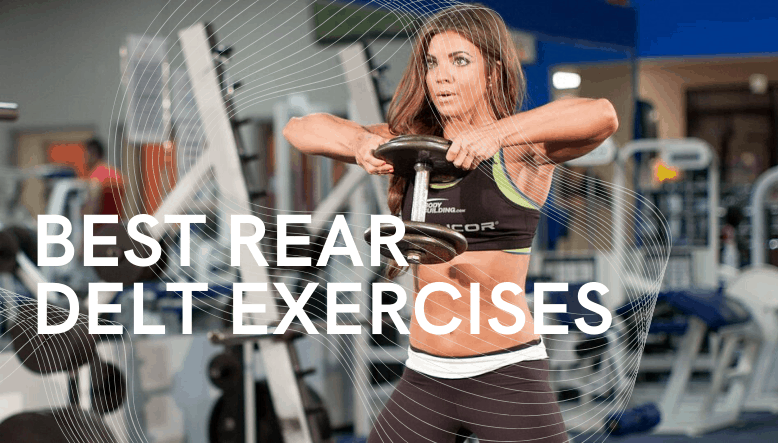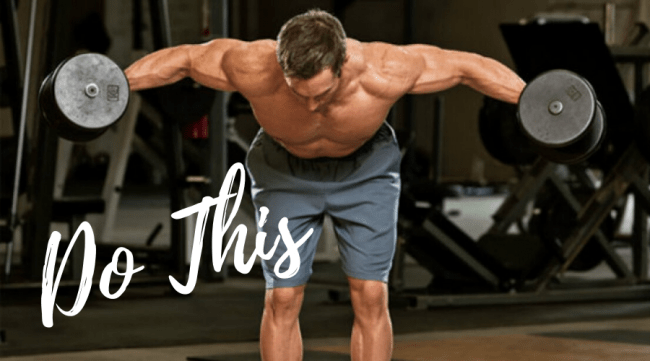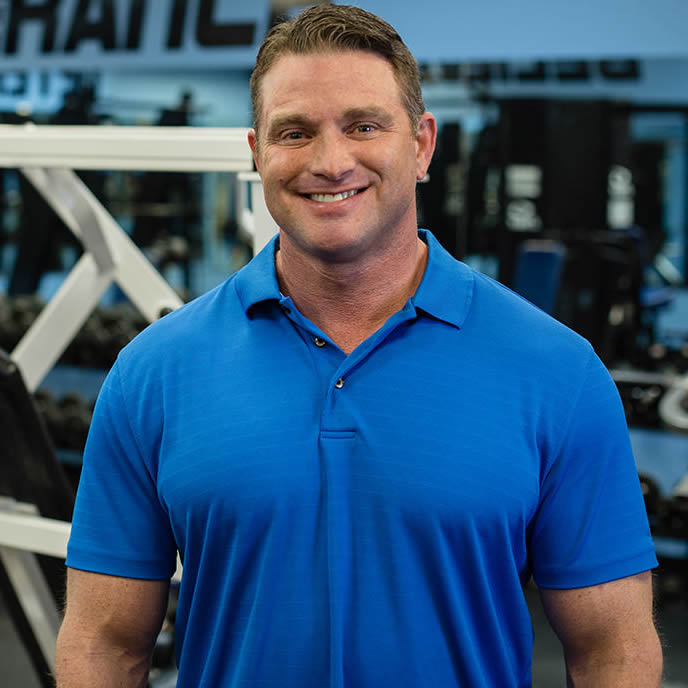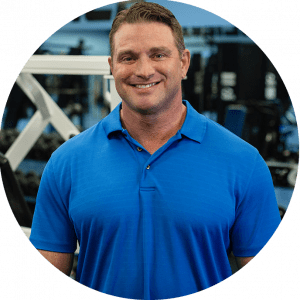
The rear delts are more like an extension of your back muscles rather than shoulder muscles. They act as a dynamic stabilizer for the shoulder and are essential for good posture. Weak rear delts are an injury risk, even if your front delts are strong.

This means that in addition to your regular diet of Overhead Presses, Frontal and Lateral Raises and Bench Press variations, you also need a decent helping of rear deltoid exercises. With that in mind, here’s our list of the top five rear deltoid exercises
Best rear delt exercises
For the sake of completeness, none of these are isolation exercises. They are all compound exercises which target the rear delts along with other muscles.
Seated Cable Rope Face Pull
You can do this with a machine or with a resistance band. For the latter, we’d suggest using a medium-strength band. Wrap it around your feet making sure that the sides of the band are of roughly equal length then bend your knees slightly and hold the ends of the band so that your hands are just above your knees, palms in.
Pull the band or pulley inwards and upwards, basically towards your face, until your knuckles are level with your cheeks (or just as far as you can). Keep your elbows higher than your forearms so that when you reach the top of the movement your arms look rather like a pair of wings. Lower smoothly back to the starting position.
Standing face pull
This is basically the same except you need either a machine or a convenient pillar or pole to which to tie a resistance band. Again, we’d suggest a medium-strength band. Anything fixed is usually good, a squat rack pole is usually absolutely fine. Just make sure that whatever you use is totally stable.
You also need to work out how to tie your band so it is the right length for the exercise, unless you have enough free space that you can adjust the tension by moving forwards or backwards relative to the pillar or pole. Basically, you want to start with the band/pulley drawn out so that the leading edge runs across your forehead, essentially where your eyebrows are. The tensions should be neutral, not slack but not taut either.
Once you’ve sorted this (or just claimed a machine), the basic movement is the same as for the seated face pull. You keep your shoulders down and your elbows above your forearms and pull back on the band/pulley so that your knuckles end up by your cheeks. This will give you a “wing-like” silhouette.

Cable High Pulley Lateral Extension
Affectionately known as the Wolverine, this may be the ultimate posterior chain exercise.
Clear all the attachments from the pulley. This means everything, including the metal clip/hook.
Set the pulley as high as you reasonably can, given your height.
Grab the left pulley with your right arm, and the right pulley with your left arm. Hold the ball-ends of the pulleys with your palms facing inwards and your arms in front of your body, in a straight line with your shoulders (which stay down).
Keeping your feet square, extend both arms in a diagonal so that you end up with them beside your body but still in a straight line with your shoulders and still with your shoulders down.
Squeeze the muscles in your upper back so that you hold the end position for, literally, a second, then return, slowly and steadily, to the starting position.
Wide Grip Inverted Row
Wide grip inverted rows place more stress on the rear delts than regular inverted rows. This is why they’re classed as one of the best rear deltoid exercises. It’s also why they’re much harder to do than regular inverted rows. On the plus side, they’re also much safer for the lower back than a wide grip barbell row.
Lie on the floor beneath the machine in the usual position, i.e. back flat and butt tucked in. When you first start out with wide grip inverted rows, you’ll probably find it best to keep your feet on the floor. As you start getting used to the exercise, you can elevate them to make the exercise tougher.
You start with your arms in a neutral position, straight up from your shoulders, elbows slightly bent. Hold the pulley handle with your palms facing in. You can swap out the pulleys for resistance bands if you find that more comfortable. We’d suggest using two medium-strength bands (one each side) and while you can adjust your grip a bit more to taste, you still need to keep your palms facing in.
Raise your bodyweight using your arms so that you reach a position where your chest is level with your shoulders and your elbows are out making a right angle with your body. If you want to make it a bit tougher but aren’t ready to raise your feet, try pausing for a second at the top.
Dumbbell Bent-Over Reverse Fly
Stand with your feet apart, bend your knees slightly and bend your upper body so that your elbows are in a line with your knees. This will mean that your butt is out, that’s fine. Keep your back neutral and your elbows slightly bent.
Grasp the dumbbells with your palms facing in and keep your palms facing in as you raise the dumbbells from the shoulders, breathing out as you do so. You want to end up with your upper arms in a line with your shoulders, your lower arms slightly below them and your hands with the dumbbells at right angles to the ground. Essentially your upper body will have the silhouette of a very large bird.
Pause and lower back to the starting position, breathing in as you do so.

Rear delt exercises conclusion
Incorporating rear delt exercises into your workouts can help to ensure that you are able to keep having workouts and not out with injury. What’s more, they can do wonders for your posture.
Jeff is a medium-sized private gym owner that has itself over 100 members and is our equipment reviewer. If it builds muscle, gets you fit or pretends to be healthy, Jeff knows all about it. Worked with Fitness Superstore as a buyer for 10 years. Seriously BIG guy with a heart to match. Always laughing and looking for a windup. Literally always eating


![Best Rear Delt Exercises [Expert Guide & Routine]](https://fitnessauthority.co.uk/wp-content/uploads/thumbs_dir/Body-Compound-Workout-omsnjcdt0p0slqgk9b6hbpqlgf9q9pgru0uzka63b0.jpg)
![Best Rear Delt Exercises [Expert Guide & Routine]](https://fitnessauthority.co.uk/wp-content/uploads/thumbs_dir/Best-Front-and-Side-Delt-Exercises1-e1588519572810-oozolabsjcxux4vg1rbhdw76tijtgdh9jknq5w4t30.png)









